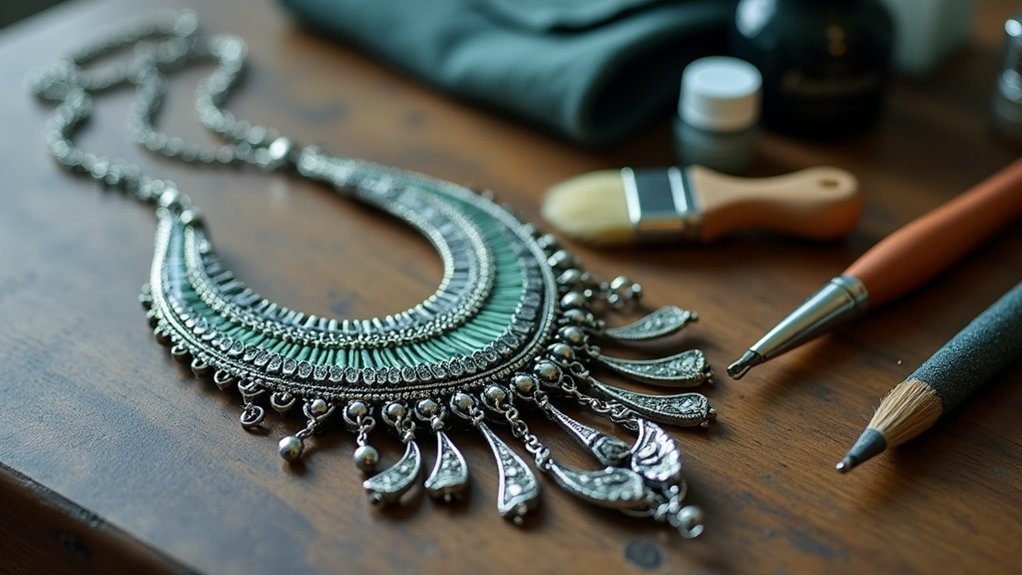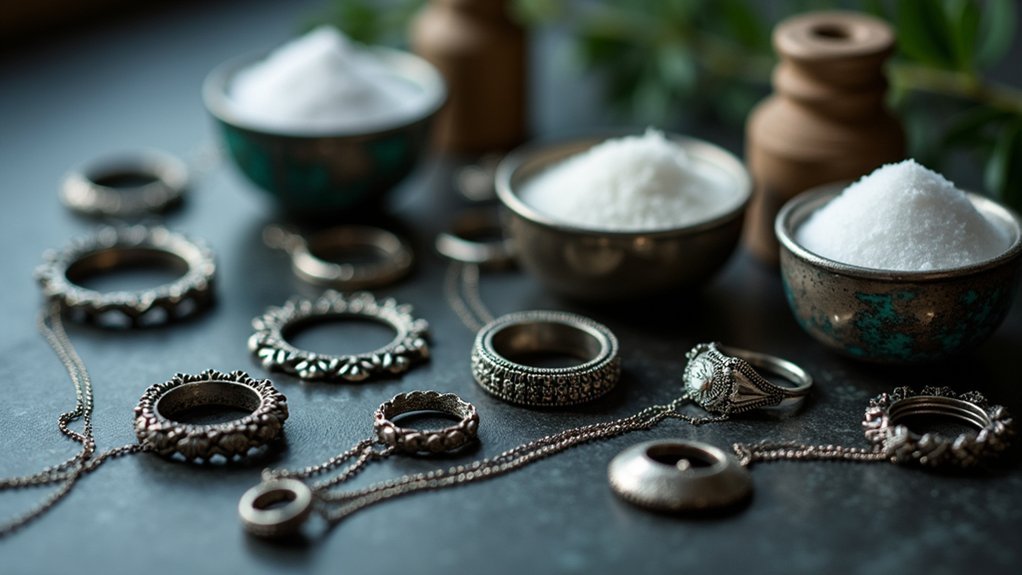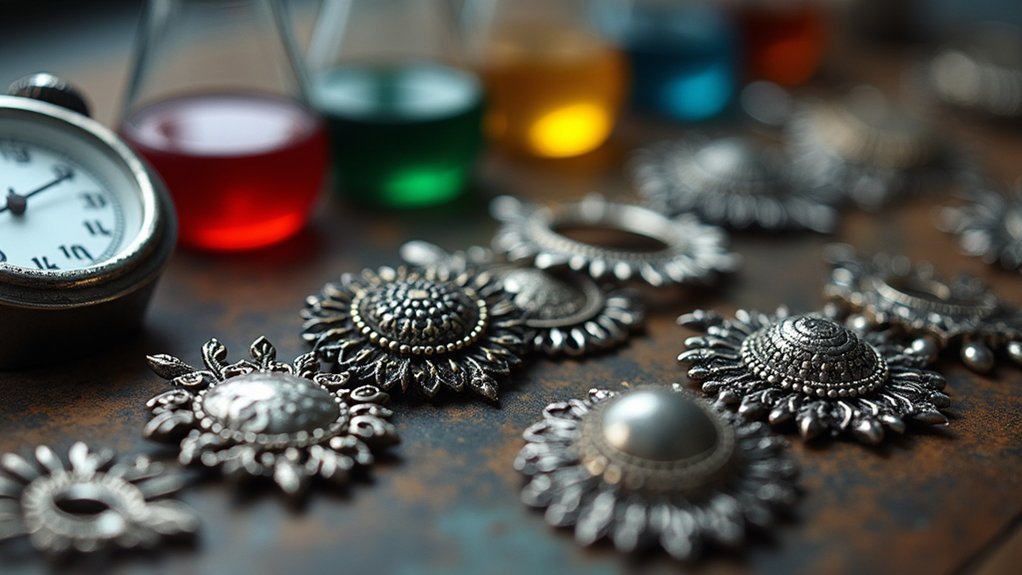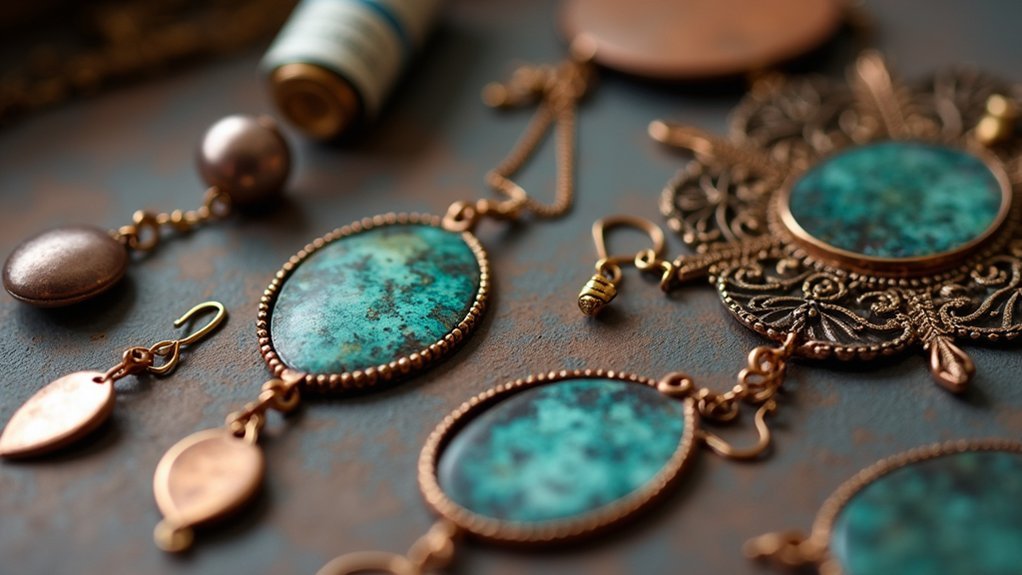You can restore your jewelry’s patina by first identifying whether damage is from natural oxidation or chemical treatments, then gathering essential tools like Liver of Sulphur, gloves, and soft cloths. Clean your pieces gently, apply patina restorers while monitoring color changes, and rinse immediately under running water once you’ve achieved the desired look. Finish by drying thoroughly and applying protective sealants to prevent future tarnishing. Proper storage techniques will help maintain your restored jewelry’s lustrous beauty for years to come.
Understanding Patina and Its Role in Jewelry Beauty

When silver and other metals interact with oxygen and sulfur compounds in the air, they develop patina—a natural oxidation layer that transforms ordinary jewelry into pieces with extraordinary character.
Unlike polished surfaces, patina creates depth and visual interest that highlights intricate designs and textures you’d otherwise miss on shiny finishes.
While polished jewelry catches the eye, patina reveals hidden artistry through shadows and highlights that showcase every deliberate detail.
You’ll notice patina produces stunning color variations, from deep blacks to rich purples, depending on the specific metals and treatment methods used.
This oxidation process gives your pieces that coveted vintage jewelry appearance that collectors prize. Oxidized silver particularly excels at emphasizing fine details and craftsmanship.
Understanding patina’s aesthetic value helps you appreciate why proper care matters—gentle cleaning preserves these unique finishes while maintaining their distinctive beauty and character.
Identifying Different Types of Patina Damage
When you’re examining damaged patina, you’ll need to distinguish between natural oxidation that occurs over time and chemical damage from harsh cleaners or environmental exposure.
Look for specific surface discoloration patterns like splotchy areas, uneven color variations, or faded sections that reveal the underlying metal.
You should also assess any structural issues such as cracks, peeling, or areas where the patina has completely worn away, as these indicate deeper problems requiring different restoration approaches.
Natural Oxidation Vs Chemical
Although silver jewelry develops patina naturally over time, you’ll need to distinguish between beneficial oxidation and harmful chemical patina damage to restore your pieces effectively.
Natural oxidation creates character through gradual reaction with oxygen and sulfur, developing rich, layered appearances that enhance your jewelry’s intricate details. This process occurs slowly, building beautiful depth over months or years.
Chemical patina damage results from harsh cleaning agents or environmental exposure, creating uneven tarnishing that compromises your piece’s aesthetic appeal. You’ll notice splotchy or overly uniform patterns that detract from natural beauty.
Key differences to identify:
- Natural patina: Rich, layered look with subtle color variations
- Chemical damage: Splotchy, uneven, or artificially uniform appearance
- Liver of sulfur treatment: Controlled dark brown to black hues
Proper care and maintenance preserves beneficial natural patina while preventing harmful chemical damage.
Surface Discoloration Patterns
Understanding surface discoloration patterns helps you identify the specific type of patina damage affecting your jewelry pieces.
You’ll notice uniform grey tones typically result from chemical treatments like bleach, while natural oxidation creates irregular darkening or mottling. Sterling silver shows brown to black hues due to copper content reacting with air and sulfur.
Splotchy or uneven patina indicates improper cleaning methods, such as using boiled eggs or harsh chemicals that cause inconsistent darkening.
When you see greenish or bluish discoloration on copper alloys, that’s corrosion from moisture or chemical exposure rather than desirable patina.
Accurately identifying these surface discoloration patterns guarantees you’ll choose appropriate restoration techniques – some damage needs gentle cleaning while others require complete patina reapplication.
Structural Damage Assessment
Beyond identifying surface discoloration, you’ll need to examine your jewelry for structural damage that could compromise restoration efforts or the piece’s longevity.
Carefully inspect each component for issues that go beyond surface-level tarnishing.
Check these critical areas during your assessment:
- Stone settings and clasps – Look for loose stones, weakened prongs, or broken mechanisms that affect functionality.
- Metal integrity – Examine for deep corrosion, pitting, or cracks beneath the patina layer.
- Overall wear patterns – Identify scratches, dents, or stress points that indicate structural weakness.
Pay special attention to vintage pieces, as they often require specialized handling during patina restoration.
Inconsistent patina patterns may reveal underlying damage that standard cleaning methods can’t address, potentially requiring professional intervention before proceeding.
Essential Tools and Materials for Patina Restoration
You’ll need specific chemical solutions like Liver of Sulphur and Clorox bleach to achieve effective patina restoration results.
Safety equipment including gloves and goggles becomes essential when working with these chemicals to protect yourself from harmful exposure.
Your basic application toolkit should include soft brushes for gentle cleaning, soft cloths for buffing, and a Tupperware container for containing your restoration process.
Primary Chemical Solutions
When restoring patina on jewelry, mastering the right chemical solutions makes all the difference between amateur and professional results.
You’ll find two primary options that deliver reliable outcomes for silver jewelry restoration.
Liver of Sulphur stands as the go-to choice for patina restoration. This versatile chemical produces stunning color variations from brown to black to purple, depending on your application timing.
You’ll achieve different hues by controlling how long the solution contacts your silver jewelry.
Clorox bleach offers an alternative approach, though it requires extra caution.
Here’s your essential safety checklist:
- Test on a small, hidden area first
- Avoid contact with stones or gems
- Monitor development closely to prevent over-darkening
Safety Equipment Required
Before diving into any patina restoration project, proper safety equipment protects you from chemical burns and respiratory irritation. You’ll need essential protective gear to handle chemicals like liver of sulfur and bleach safely.
| Safety Equipment | Purpose |
|---|---|
| Gloves and Goggles | Protect your skin and eyes from harmful chemicals |
| Ventilation System | Prevent inhalation of toxic fumes |
| Emergency Supplies | Neutralize spills and rinse residue |
Always work in a well-ventilated area or use a fume hood when applying chemical treatments. Keep water nearby for immediate rinsing after chemical application. Having baking soda ready helps neutralize accidental spills. These precautions guarantee you can restore your jewelry’s patina safely while avoiding potential health hazards from chemical exposure.
Basic Application Tools
Five essential tools form the foundation of any successful patina restoration project.
You’ll need protective gloves to shield your hands from chemicals, a small mixing dish for preparing solutions, and a soft brush for even application.
Don’t forget tweezers for safely handling jewelry when using Liver of Sulphur solutions.
Temperature control matters greatly. Use a thermometer to maintain water around 120°F (49°C) for ideal chemical reactions.
Keep these additional items ready:
- Non-abrasive cloth for basic cleaning and drying
- Soft cloth for final polishing without scratching
- Water container for immediate rinsing
Having water nearby prevents over-darkening by stopping the patina process instantly.
If you’re uncertain about chemical handling or valuable pieces, consider seeking professional help before proceeding.
Preparing Your Jewelry for the Restoration Process
Although restoring jewelry’s original luster requires patience and care, you’ll achieve the best results by properly preparing both your workspace and pieces beforehand.
Start by thoroughly examining each piece for tarnishing, scratches, or loose stones to determine what restoration steps you’ll need. Set up your workspace in a well-lit area with a non-abrasive surface to protect delicate items.
Gather your essential cleaning tools: a soft cloth, soft brush, warm water, and baking soda. These gentle materials will effectively remove patina without causing damage.
Before beginning any cleaning process, avoid harsh chemicals that could harm your jewelry’s materials. If you’re dealing with valuable or intricate pieces, consult a professional jeweler for guidance on proper handling techniques.
Step-by-Step Liver of Sulphur Application Method

Now you’ll apply liver of sulphur to create your desired patina effect through careful preparation, precise timing, and proper finishing techniques.
You must follow specific safety protocols and mixing ratios before beginning the chemical process.
The key to successful patina restoration lies in controlling your application timing and completing thorough rinsing and protective coating steps.
Preparation and Safety Steps
Proper preparation forms the foundation of safe and successful liver of sulphur application for jewelry patina restoration.
Before you begin, you’ll need to establish proper preparation and safety steps to protect yourself and achieve ideal results.
Start by gathering your essential tools:
- Protective gear – Put on gloves and safety goggles to prevent skin irritation and eye contact
- Glass container – Use only glass or ceramic vessels, never metal containers
- Warm water – Have clean, warm water ready for mixing the solution
Always work in a well-ventilated area to avoid inhaling potentially harmful fumes.
The chemical reaction produces hydrogen sulfide gas, which can be irritating to your respiratory system. Open windows or work outdoors when possible to guarantee adequate airflow throughout the process.
Application Timing Techniques
Once you’ve prepared your liver of sulphur solution, timing becomes essential for achieving your desired patina effect. Monitor your silver jewelry closely during the application process, as color changes happen rapidly—from brown to black to purple within seconds or minutes.
Remove pieces immediately when you reach your preferred shade, then rinse thoroughly under cool running water to halt the chemical reaction.
For precise control, use a cotton swab or soft brush for targeted application on specific areas. This method allows you to selectively darken certain sections while preserving others.
After rinsing, dry completely with a soft cloth and apply protective wax. This final step helps restore its shine while preventing unwanted tarnishing of your newly patinated jewelry.
Rinsing and Finishing
Two critical steps determine the success of your liver of sulphur patina: proper rinsing and thorough finishing.
Once you’ve achieved your desired color, immediately rinse the jewelry under running water to stop the darkening process and remove residual chemicals.
Follow these essential finishing steps:
- Rinse thoroughly under running water until all liver of sulphur is removed
- Dry gently with a soft cloth, patting rather than rubbing the surface
- Air dry completely before storing to prevent moisture damage
After your jewelry’s completely dry, consider applying a protective coating like wax to preserve the new patina and repel moisture.
This coating helps maintain your restoration work and prevents unwanted tarnishing. Proper rinsing and finishing guarantee your patina restoration lasts longer while protecting the underlying metal.
Alternative Chemical Restoration Techniques

Beyond traditional patina methods, several chemical alternatives can restore your jewelry’s aged appearance with varying degrees of control and predictability. Clorox bleach offers effective patina restoration when used carefully.
You’ll need to avoid contact with gemstones and wear protective gear since you’re working with harsh chemicals. This method produces uniform grey tones that complement many jewelry styles better than varied hues from other techniques.
Before applying bleach to your entire piece, test it on an inconspicuous area first. After treatment, rinse thoroughly with water to remove chemical residue that could damage your jewelry over time. Use a soft cloth to gently dry the piece afterward.
For non-chemical alternatives, place jewelry with crushed boiled egg in a sealed container, though this may create splotchy results.
Natural Patina Restoration Using Boiled Eggs
When you’re seeking a gentler approach to patina restoration, hard-boiled eggs provide a natural alternative that harnesses sulfur’s tarnishing properties. Crush the boiled egg and place it with your jewelry in a sealed Tupperware container. The released sulfur will gradually tarnish the surface of the metal over several hours.
Follow these essential steps for best results:
- Use hard-boiled eggs rather than soft-boiled for consistent patina development.
- Monitor your jewelry closely and check periodically for desired effects.
- Rinse thoroughly with water when finished to remove all egg residue.
While this method offers a chemical-free solution, expect potentially splotchy outcomes with less control than traditional techniques.
Always dry completely and use a soft cloth to prevent scratching during the patina restoration process.
Timing and Color Control During the Restoration Process

Achieving the perfect patina color requires precise timing and constant attention to your jewelry’s transformation. When using Liver of Sulphur, you’ll notice your metal progressing through distinct stages—from brown to black to purple.
Check your piece every 30 seconds to one minute, as different metals react at varying rates. This careful monitoring lets you restore the exact hue you’re seeking.
The final color you achieve depends entirely on exposure duration, giving you complete control over your jewelry’s appearance. If you’re using Clorox bleach for a uniform grey look, timing remains equally critical to prevent overexposure.
Once you’ve reached your desired color, immediately rinse your jewelry under water. This stops the chemical reaction and preserves your perfectly restored patina.
Proper Rinsing and Finishing Techniques
Since you’ve stopped the chemical reaction at the perfect moment, your next essential step involves thorough rinsing to lock in that ideal patina color.
Immediately flood your jewelry with cool or lukewarm water to remove all chemical residues that could cause unwanted discoloration later.
Pay special attention to these critical areas during rinsing:
- Deep crevices and intricate details where chemicals accumulate
- Areas around stones or delicate components that need gentle handling
- Joint connections and clasps that trap residue
After complete rinsing, gently pat your jewelry dry with a soft cloth—never rub, as this can damage your newly achieved patina.
Once thoroughly dried, apply a protective wax or lacquer coating to preserve your restoration work and enhance the patina’s longevity for years to come.
Protecting Restored Patina With Sealants

Although your patina restoration looks perfect now, it won’t stay that way without proper protection from everyday wear and environmental factors.
Clear acrylic sealants offer excellent defense against scratches, moisture, and tarnishing, greatly extending your jewelry’s restored finish.
Clear acrylic sealants provide superior protection against scratches, moisture, and tarnishing while preserving your jewelry’s beautifully restored patina finish.
Choose sealants specifically formulated for metal surfaces to prevent damaging chemical reactions with your patina.
Wait until the restoration completely cures before applying any protective coating—this guarantees ideal adhesion and effectiveness.
Apply thin, even coats to maintain the natural appearance and texture you’ve worked to achieve.
Heavy application can alter the patina’s look and feel.
Once sealed, maintain your jewelry through gentle cleaning to prevent buildup that could compromise both the sealant and underlying patina, keeping your restoration beautiful for years.
Storage and Maintenance Tips for Long-Lasting Results
Even with protective sealants in place, your restored patina’s longevity depends heavily on proper storage and ongoing maintenance practices.
You’ll want to store your jewelry in ideal conditions that prevent deterioration and maintain that beautiful finish you’ve worked to restore.
Follow these essential storage guidelines:
- Use soft pouches or zip-bags – This will prevent scratches and keep pieces separated from each other.
- Choose air-tight containers – These minimize exposure to moisture and air that accelerate tarnishing.
- Add anti-tarnish strips or cloths – They help preserve your jewelry’s integrity and appearance.
Always avoid direct sunlight and heat when selecting storage locations, as these conditions degrade materials over time.
Regularly inspect your stored pieces for any signs of tarnish or damage, enabling timely maintenance.
Frequently Asked Questions
How to Bring Old Jewelry Back to Life?
You’ll restore old jewelry by first evaluating its condition and metal type. Use liver of sulphur for silver patina, clean gently with mild soap, and store pieces separately with anti-tarnish strips for lasting results.
How to Remove Patina From Jewelry?
You’ll remove patina by using a silver polishing cloth to gently buff tarnished areas. Alternatively, create a baking soda paste, apply it carefully, then rub with soft cloth until shine returns.
What Is the Difference Between Patina and Tarnish Silver?
You’ll find patina’s an intentional, desirable oxidation that creates beautiful antique finishes, while tarnish is unwanted discoloration you’ll want to remove. Patina adds character and value; tarnish dulls your silver’s appearance.
How to Restore Patina on Silver?
You can restore silver patina using liver of sulphur for controlled darkening, Clorox bleach for uniform graying, or crushed boiled eggs in containers. Always rinse thoroughly afterward and monitor timing carefully.
In Summary
You’ve now mastered the art of patina restoration and can breathe new life into your treasured jewelry pieces. With proper technique, timing, and care, you’ll achieve professional-looking results that enhance your jewelry’s natural beauty. Remember to store your restored pieces properly and perform regular maintenance to preserve that perfect patina finish. Your jewelry collection will thank you for this newfound skill that keeps your pieces looking stunning for years to come.





Leave a Reply